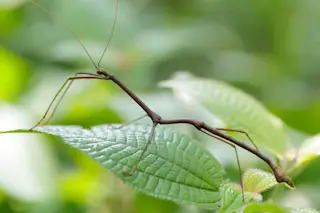(Credit: Stephane Bidouze/Shutterstock)The stick insect may have something else in common with plants besides its stem-like looks. Plants use wildlife to spread seeds, and, similarly, the stick insect might use wildlife to spread its eggs, a study in the journal Ecology reported this week.
Most of a stick insect’s life is spent in a circle of trees and bushes, even for those species with wings. The insect would have an evolutionary advantage if it could disperse its young more widely. But with twig-like legs and wimpy flappers, the insect is not going to get too far. Some plants use wind, water and birds to disperse their seeds. For those favoring avian-mediated transport, the seeds are eaten, the birds fly away and eventually poop. The seed germinates into a plant at a distant site. Stick insects (i.e., plasmids, in the order Phasmatodea) might use birds in a similar manner. But how ...














